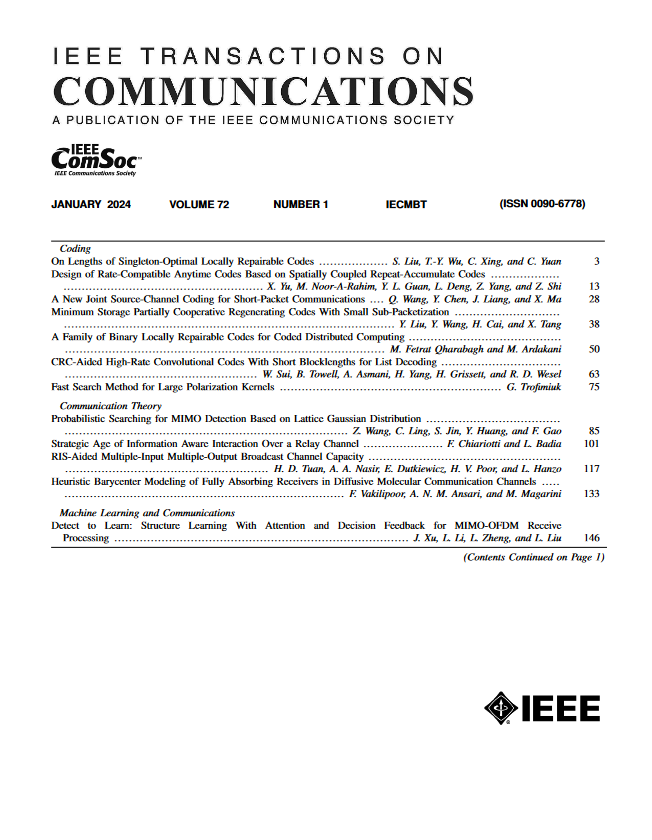带能量充电的无人机辅助缓存计算网络延迟最小化资源分配与轨迹优化
IF 8.3
2区 计算机科学
Q1 ENGINEERING, ELECTRICAL & ELECTRONIC
引用次数: 0
摘要
空地融合网络能够弥补地面5G网络覆盖范围小、资源部署固定的局限性,通过边缘计算提供灵活的服务。但是,重复的数据可能会被卸载到边缘服务器,造成网络资源的浪费。同时,由于无人机机载能量存储有限,需要重点研究无人机的续航力和飞行轨迹优化问题。此外,网络节点的高度动态性将导致信息不确定性和维度诅咒的困境。为了应对上述挑战,我们设计了一种无人机辅助的异构缓存计算网络模型,其中设备分为两类:需要卸载任务的请求地面设备(RGD)和通过设备到设备(D2D)链路处理从RGD卸载的任务的自由地面设备(FGD)。然后提出了联合优化缓存策略、任务分割、计算资源分配和无人机轨迹规划的问题,以最小化无人机能量充电约束下的系统延迟。由于离散变量和连续变量并存,以及长期能量约束和短期决策的耦合,我们将其分解为两个子问题。采用低复杂度匹配算法选择最优的无人机任务缓存策略,利用Lyapunov优化对第二子问题进行分解,利用CVX解决任务分割和局部计算资源分配问题,采用软行为者批评(SAC)方法实现FGD和无人机计算资源分配以及轨迹规划。大量的仿真结果表明,与基准测试相比,我们的算法在减少系统延迟方面具有优势。本文章由计算机程序翻译,如有差异,请以英文原文为准。
Latency Minimization Resource Allocation and Trajectory Optimization for UAV-Assisted Cache-Computing Network With Energy Recharging
Air-ground integrated network is able to make up for the limitations of small coverage as well as fixed resource deployment of ground 5G network and provide flexible services via edge computing. However, duplicated data may be offloaded to edge server, resulting in waste of network resources. In the meantime, due to the limited on-board energy storage of unmanned aerial vehicle (UAV), the endurance and trajectory optimization of UAV need to be focused on. Moreover, the high dynamics of network nodes will lead to the dilemma of information uncertainty and curse of dimensionality. In order to tackle the above challenges, we design a UAV-assisted heterogeneous cache-computing network model, among which, devices are divided into two categories: the request ground device (RGD) which requires task offloading and the free ground device (FGD) which can process offloaded tasks from the RGD through the device-to-device (D2D) link. Then we formulate a problem of jointly optimizing cache strategy, task segmentation, computing resource allocation and UAV trajectory planning to minimize the system latency constrained by UAV energy recharging. Due to the coexistence of discrete and continuous variables as well as coupling between long-term energy constraint and short-term decision making, we decompose it into two sub-problems. Low complexity matching algorithm is used to select the optimal UAV task caching strategy, while Lyapunov optimization is leveraged to decompose the second sub-problem, for which CVX is utilized to solve the task segmentation and local computing resource allocation, and soft actor-critic (SAC) approach is used to realize the computing resource allocation of FGD and UAV plus trajectory planning. Extensive simulation results showcase the advantages of our algorithm in reducing the system latency compared to benchmarks.
求助全文
通过发布文献求助,成功后即可免费获取论文全文。
去求助
来源期刊

IEEE Transactions on Communications
工程技术-电信学
CiteScore
16.10
自引率
8.40%
发文量
528
审稿时长
4.1 months
期刊介绍:
The IEEE Transactions on Communications is dedicated to publishing high-quality manuscripts that showcase advancements in the state-of-the-art of telecommunications. Our scope encompasses all aspects of telecommunications, including telephone, telegraphy, facsimile, and television, facilitated by electromagnetic propagation methods such as radio, wire, aerial, underground, coaxial, and submarine cables, as well as waveguides, communication satellites, and lasers. We cover telecommunications in various settings, including marine, aeronautical, space, and fixed station services, addressing topics such as repeaters, radio relaying, signal storage, regeneration, error detection and correction, multiplexing, carrier techniques, communication switching systems, data communications, and communication theory. Join us in advancing the field of telecommunications through groundbreaking research and innovation.
 求助内容:
求助内容: 应助结果提醒方式:
应助结果提醒方式:


